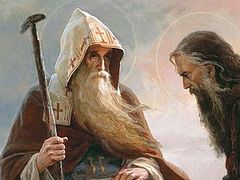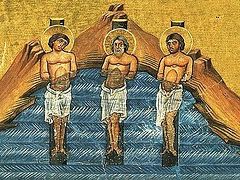 Holy Martyrs Theodore the Varangian and his son John lived in Kiev in the tenth century, when the Varangians, ancestors of the modern Swedes and Norwegians, played an especially active role in the state and military life of Rus’. Merchants and warriors, they pioneered new trade routes to Byzantium and the East, participated in campaigns against Constantinople, and formed a significant part of the population of ancient Kiev and the princely mercenary armies. The main trade route of Rus’ from the Baltic Sea to the Black Sea was then called the “route from the Varangians to the Greeks.”
Holy Martyrs Theodore the Varangian and his son John lived in Kiev in the tenth century, when the Varangians, ancestors of the modern Swedes and Norwegians, played an especially active role in the state and military life of Rus’. Merchants and warriors, they pioneered new trade routes to Byzantium and the East, participated in campaigns against Constantinople, and formed a significant part of the population of ancient Kiev and the princely mercenary armies. The main trade route of Rus’ from the Baltic Sea to the Black Sea was then called the “route from the Varangians to the Greeks.”
The Varangian troops were relied upon by the leaders and organizers of early Russian statehood. Like the Slavs among whom they lived, many of the foreign settlers, under the influence of the Byzantine Church, received Holy Baptism. Kievan Rus’ occupied a central position between pagan Scandinavia and Orthodox Byzantium. Therefore, the spiritual life of Kiev was alternately dominated by the life-giving influence of the Christian faith coming from the south (during the reign of blessed Askold in 860–882; under Prince Igor and St. Olga in the 940–950s) and the destructive whirlwinds of paganism coming from the north, from the Varangian Sea (during the reign of Oleg, who killed Askold in 882, during the revolt of the Drevlyans, who killed Igor in 945, and during the reign of Prince Svyatoslav, who refused to be baptized despite the pleas of his mother, Equal-to-the-Apostles Olga).
When Svyatoslav was killed by the Pechenegs in 972 (or in 970, according to other sources), his eldest son, Yaropolk, remained the Grand Prince of Kiev. The middle son, Oleg, legendary Volga Svyatoslavich, ruled the Drevlyan land, and the youngest, Vladimir, ruled Novgorod. Yaropolk's rule (970–978), like that of his grandmother Olga, once again became a time of great Christian influence on the spiritual life of Rus’. According to historians, Yaropolk had accepted Christianity—although possibly of the Latin rite—which did not align with the interests of the Scandinavian pagan troops, who considered Kiev the stronghold of their influence in the Slavic lands. Their leaders tried to incite discord between the brothers, leading to a civil war between Yaropolk and Oleg. After Oleg was killed, they supported Vladimir in the struggle against Yaropolk.
The future baptizer of Rus’ began his path as a convinced pagan and relied on the Varangians, whom he had intentionally brought from across the sea as a military force. His campaign against Kiev in 978, which culminated in complete success, pursued not only military-political goals. It was a religious campaign of Russian-Varangian paganism against the nascent Kiev Christianity. On June 11, 978, Vladimir “sat on the throne of his father in Kiev,” and the unfortunate Yaropolk, invited by his brother for negotiations, was treacherously killed by two Varangians who pierced him with swords at the entrance to the feast hall. In order intimidate the Kievans, among whom many—both Russians and Varangians—were already Christians, human sacrifices, previously unknown among the Dnieper Slavs, were performed in the pagan temple, restored and adorned with new idols. The Chronicle says of the idols set up by Vladimir: “And they offered them sacrifices, calling them gods, and brought their sons and daughters to them, and sacrificed them to demons... And the land of Rus’, and that hill, were defiled with blood.”
Apparently, it was during this first period of the triumph of paganism in Kiev under Vladimir's rule that the holy martyrs Theodore the Varangian and his son John were killed. This can be dated to July 12, 978. However, it is possible that the martyric labors of the holy Varangian martyrs of Kiev took place in the summer of 983, when a wave of pagan reaction swept not only across Rus’ but throughout the Slavic-Germanic world. Almost simultaneously, pagans rose up against Christ and the Church in Denmark, Germany, and the Baltic Slavic principalities. Everywhere the unrest was accompanied by the destruction of churches, and the killing of clergy and other Christians. In that year, Vladimir campaigned against the Lithuanian tribe of the Yatvyags and defeated them. In commemoration of this victory, Kiev priests decided to once again arrange a bloody sacrifice.
Among the Kievans lived a Varangian named Theodore, who had long served in the military in Byzantium and received Holy Baptism there, as reported by St. Nestor the Chronicler. His pagan name, from in the term, “Turova boznitsa,” was Tur (Scandinavian Thor) or Utor (Scandinavian Ottar); both spellings are found in old manuscripts. Theodore had a son John, a handsome and pious youth, who was a Christian like his father.
“And the elders and boyars said: Let us cast lots on the boys and girls, and on whom it falls, him we will sacrifice to the gods." Evidently, not without some manipulation, the lot cast by the pagan priests fell on the Christian John.
When those sent to Theodore reported that his son “was chosen by the gods, so let us bring him as a sacrifice to them,” the old warrior resolutely replied: “They are not gods but wood. Today they exist, and tomorrow they will rot. They neither eat, drink, nor speak but are made by human hands from wood. There is one God, whom the Greeks serve and worship. He created heaven and earth, the stars, the moon, the sun, and man, whom he predestined to live on earth. And what did these gods create? They themselves are created. I will not give my son to demons.”
 Murder of Martyrs Theodor the Varangian and his son John. Radziwiłł Chronicle. Photo: wikipedia.org
Murder of Martyrs Theodor the Varangian and his son John. Radziwiłł Chronicle. Photo: wikipedia.org
This was a direct challenge from a Christian to the customs and beliefs of the pagans. The armed pagans rushed to Theodore, destroyed his yard, and surrounded the house. According to the chronicler, Theodore bravely “stood on the gallery with his son,” armed and facing the enemies. (In old Russian houses, a staircase on pillars leading to the second floor was called the gallery). He calmly looked at the frenzied pagans and said, “If they are gods, let them send one of the gods and take my son.” Seeing that they could not defeat the brave and skilled warriors Theodore and John in an honest fight, the besiegers undercut the gallery pillars, and when it collapsed, they overwhelmed the holy confessors and killed them.
Less than a hundred years after the Kiev Varangians’ Christian confession, during the time of St. Nestor the Chronicler, the Russian Orthodox Church already venerated them among the saints. Theodore and John became the first martyrs for the holy Orthodox faith in the Russian land. They were called the first “Russian citizens of the heavenly city” by the writer of the Kievan Caves Patericon, Holy Hierarch Simon of Suzdal († 1226; commemoration on May 10). The last of the bloody pagan sacrifices in Kiev became the first holy Christian sacrifice—co-crucifixion with Christ. The “route from the Varangians to the Greeks” was becoming for Rus’ a path from paganism to Orthodoxy, from darkness to light.
On the site of the Varangians’ martyrdom, Holy Equal-to-the-Apostles Vladimir later erected the Church of the “Tithes”, of the Dormition of the Most Holy Theotokos, consecrated on May 12, 996 (celebrated on May 12). In 1007, the relics of Holy Equal-to-the-Apostles Olga were transferred to this church. Eight years later, St. Vladimir himself, who baptized the Russian land, found his final resting place here, and in 1044, his son, Yaroslav the Wise, transferred the remains of his uncles, Yaropolk and Oleg, to this church after “baptizing their bones.” This was evidently due to the requirement of church rules for the re-baptism of a Christian in the absence of reliable evidence of the first baptism. On the other hand, ancient Kiev attached great importance to ancient Christian stories about the possibility of posthumous Baptism of people who died outside the Church, by special grace of God.1 Such a story is read, for example, in the famous monument of ancient Russian didactic literature, the Izbornik of 1076, belonging to the son of Yaroslav the Wise, the pious Prince Svyatoslav († 1076).
God is wondrous in His saints. Time spares neither stone nor bronze, but the lower log house of the holy Varangian martyrs, most of which burned down a thousand years ago, has nevertheless survived to this day. It was discovered in 1908 during excavations in Kiev, near the altar of the Church of the Tithes.2



